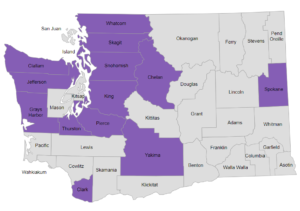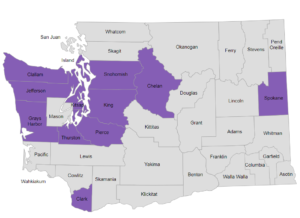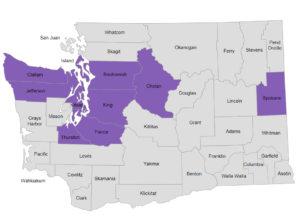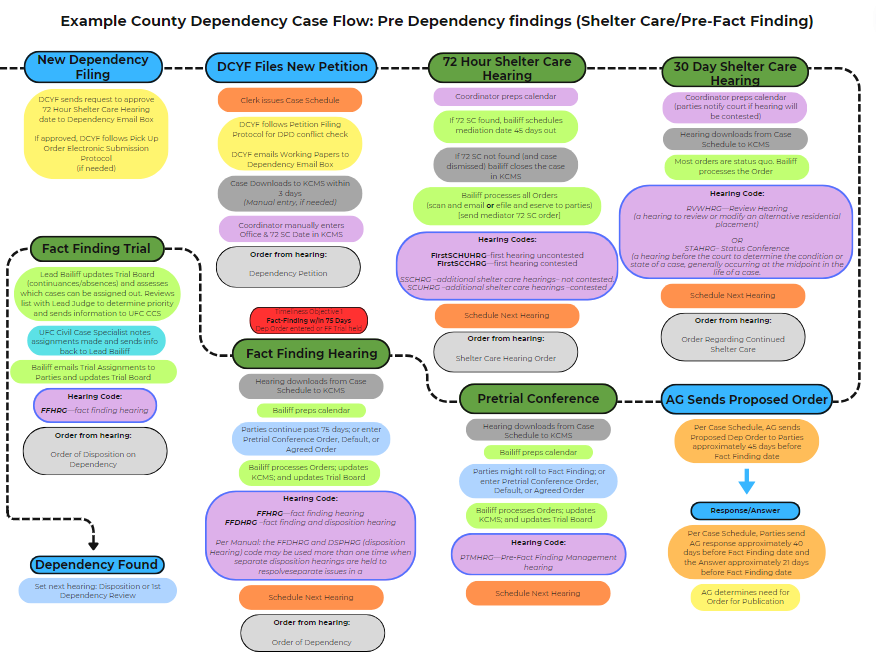Written in 2011 and updated in 2014 by Carrie Hoon Wayno1
Chapter 14 Definition of Dependency pdf
Chapter Sections
§1 Statutory Elements of a Dependency
A dependent child is defined as any child who
- a) Has been abandoned;
- b) Is abused or neglected by a person legally responsible for the care of the child; or
- c) Has no parent, guardian, or custodian capable of adequately caring for the child, such that the child is in circumstances which constitute a danger of substantial damage to the child’s psychological or physical development; or
- (d) Is receiving extended foster care services.2
§2 Abandonment
A child is “abandoned” when the child’s parent, guardian, or other custodian has expressed, either by statement or conduct, an intent to forego, for an extended period, parental rights or responsibilities despite an ability to exercise such rights and responsibilities. If the court finds that the petitioner has
exercised due diligence in attempting to locate the parent, no contact between the child and the child’s parent, guardian, or other custodian for a period of three months creates a rebuttable presumption of abandonment, even if there is no expressed intent to abandon.3
§3 Abuse or Neglect Generally
§3a General Definition
““Abuse or neglect” means sexual abuse, sexual exploitation, or injury of a child by any person under circumstances which cause harm to the child’s health, welfare, or safety … or the negligent treatment or maltreatment of a child by a person responsible for or providing care to the child.”4
Actual harm need not be proved to establish dependency based on abuse or neglect.5 A child may be found to face clear and present danger of suffering abuse when a sibling is found to have suffered abuse6 or when a parent fails to protect their child from the danger of harm.7
§3b Physical Abuse
““Physical abuse” means the non-accidental infliction of physical injury or physical mistreatment on a child.”8 Physical abuse includes, but is not limited to, actions such as throwing, kicking, burning, or cutting a child; striking a child with a closed fist; shaking a child under age three; interfering with a child’s breathing; threatening a child with a deadly weapon; or doing any other act that is likely to cause and which does cause bodily harm greater than transient pain or minor temporary marks or which is injurious to the child’s health, welfare, and safety.9 Force used to touch or strike a child is considered physical abuse when it is unreasonable or immoderate.10
§3c Sexual Abuse
“Sexual abuse” means committing or allowing to be committed any sexual offense against a child as defined in the criminal code. This includes the intentional touching, either directly or through the clothing, of the sexual or other intimate parts of a child or allowing, permitting, compelling,
encouraging, aiding, or otherwise causing a child to engage in touching the sexual or other intimate parts of another for the purpose of gratifying the sexual desire of the person touching the child, the child, or a third party. A parent or guardian of a child, a person authorized by the parent or guardian to provide childcare for the child, or a person providing medically recognized services for the child, may touch a child in the sexual or other intimate parts for the purposes of providing hygiene, child care, and medical treatment or diagnosis.11
§3d Sexual Exploitation
Sexual exploitation includes allowing, permitting, or encouraging a child to engage in prostitution or engaging in the obscene or pornographic photographing, filming, or depicting of a child.12
§3e Negligent Treatment or Maltreatment
““Negligent treatment or maltreatment” means an act or a failure to act, or the cumulative effects of a pattern of conduct, behavior, or inaction, that evidences a serious disregard of consequences of such magnitude as to constitute a clear and present danger to a child’s health, welfare, or safety.”13
A dependency finding does not require proof of actual harm. Rather, all that must be proven is that a clear and present danger to the child’s health, welfare, and safety exists.14
A parent’s failure to provide emotional nurturing, stability, and permanence can be as harmful to a child’s well-being as physical abuse or failure to provide food, shelter, and clothing. As a result, failing to provide emotional nurturing, stability, and permanence may constitute neglect.15
§3f Other Considerations
When considering whether a clear and present danger exists, evidence of a parent’s substance abuse as a contributing factor to negligent treatment or maltreatment must be given great weight by the court.16 However, poverty, homelessness, or exposure to domestic violence that is perpetrated against someone other than the child does not constitute negligent treatment or maltreatment in and of itself.17
A court may also consider the parent’s noncompliance with voluntary services designed to ameliorate child neglect where the Department of Social and Health Services (DSHS) has offered appropriate and reasonable services, but the parent refuses to accept or fails to obtain available and appropriate treatment or services, or is unable or unwilling to participate in or successfully and substantially complete the treatment or services.18
§4 “No Parent Capable”
A dependency on grounds that there is no parent, guardian, or custodian capable of adequately caring for the child, such that the child is in circumstances which constitute a danger of substantial damage to his psychological or physical development, does not turn on parental “unfitness” in the usual sense; rather, it allows consideration of both a child’s special needs and any limitations or other circumstances which affect a parent’s ability to respond to those needs.19
The existing ability or capacity of parents to adequately and properly care for their children is inconsistent with the status of dependency.20 Further, poverty of the parent, in and of itself, does not make children dependent children within the meaning of the statute unless that poverty renders the children destitute of a suitable home.21
Download this chapter: Chapter 14 – Definition of Dependency
ENDNOTES
- Carrie Hoon Wayno is an Assistant Attorney General with the Washington State Attorney General’s Office. She is the lead counsel to the Children’s Administration Assistant Secretary, coordinates juvenile litigation appeals, and provides child welfare practice advice and training to Assistant Attorneys General state-wide. Ms. Wayno graduated from the University of Washington in 1998, and from the UW School of Law in 2001. She thereafter joined the Attorney General’s Office, initially representing the Department of Labor and Industries, and soon also representing the Department of Social and Health Services. Ms. Wayno represented DSHS in child welfare cases in Clark, Cowlitz, Skamania, and Pierce Counties. She also serves as Co-chair of the WSBA Juvenile Law Section Executive Committee.
- RCW 13.34.030(6)(a)–(d).
- RCW 13.34.030(1). See also WAC 388-15-011.
- RCW 26.44.020(1).
- See In re J.F., 109 Wn. App. 718,731, 37 P.3d 1227 (2001).
- See In re Frederiksen, 25 Wn. App. 726, 733, 610 P.2d 371 (1979).
- See In re J.F., 109 Wn. App. at 731.
- WAC 388-15-009(1).
- WAC 388-15-009(1).
- See RCW 9A.16.100; State v. Russell, 69 Wn. App. 237, 246–247, 848 P.2d 743 (1993); State v. Schlichtmann, 114 Wn. App. 162, 169, 58 P.3d 901 (2002)
- WAC 388-15-009(3).
- RCW 26.44.020(22). See also WAC 388-15-009(4).
- RCW 26.44.020(16). See also Marcum v. Dep’t. of Soc. & Health Svcs., 172 Wn. App. 546, 549, 290 P.3d 1045 (2012).
- See In re J.F., 109 Wn. App. 718, 37 P.3d 1227 (2001).
- In re Dodge, 29 Wn. App. 486, 628 P.2d 1343 (1981).
- RCW 26.44.020(16).
- RCW 26.44.020(16); see also WAC 388-15-009(5).
- See RCW 26.44.195(4).
- In re Schermer, 161 Wn.2d 927, 169 P.3d 452 (2007).
- In re Walker, 43 Wn.2d 710, 715, 263 P.2d 956 (1953).
- In re Warren, 40 Wn.2d 342, 345, 243 P.2d 632 (1952).
